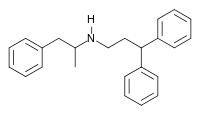Prenylamine
Prenylamine (Segontin) is a calcium channel blocker of the amphetamine chemical class which was used as a vasodilator in the treatment of angina pectoris; it was introduced in the 1960s by German manufacturer Albert-Roussel pharma gmbh[1][2] which was acquired by Hoechst AG in 1974 and which in turn became part of Sanofi Aventis in 2005.
 | |
| Clinical data | |
|---|---|
| Other names | N-(3,3-diphenylpropyl)amphetamine |
| Routes of administration | Oral |
| ATC code | |
| Legal status | |
| Legal status |
|
| Identifiers | |
IUPAC name
| |
| CAS Number | |
| PubChem CID | |
| ChemSpider | |
| UNII | |
| ChEMBL | |
| ECHA InfoCard | 100.006.246 |
| Chemical and physical data | |
| Formula | C24H27N |
| Molar mass | 329.48 g/mol g·mol−1 |
| 3D model (JSmol) | |
SMILES
| |
InChI
| |
| | |
It was withdrawn from market worldwide in 1988 because it caused QT prolongation and Torsades de pointes which in turn caused sudden death.[1][3]
The cardiac side effects were not detected during clinical development, but only emerged after the drug was widely used.[1]
Prenylamine has two primary molecular target in human, Calmodulin and Myosin light-chain kinase 2 found in skeletal and cardiac muscle.[4] Pharmacologically, it decreases the sympathetic stimulation on cardiac muscle predominantly through partial depletion of catecholamine via competitive inhibition of reuptake by storage granule, which lead to further depletion due to spontaneous leakage as a result of disturbance of equilibrium.[5] This depletion mechanism is similar to reserpine because both agents target the same site on storage granule, however prenylamine shows a high affinity for cardiac tissue while reserpine is more selective toward brain tissue.[6] Prenylamine also slows cardiac metabolism via calcium transport delay by blockade of magnesium-dependent calcium transport ATPase. It also demonstrate a beta blocker-like activity that result in reduction of heart rate however shows opposing effect on tracheal tissue response.[5]
References
- Shah, Rashmi R. (2007). "Withdrawal of Terodiline: A Tale of Two Toxicities". In Mann, Ronald D.; Andrews, Elizabeth B. (eds.). Pharmacovigilance (2nd ed.). Chichester, England: John Wiley & Sons. p. 116. ISBN 9780470059227.
- Godfraind, Theophile; Herman, Arnold G.; Wellens, Donald (2012). Calcium Entry Blockers in Cardiovascular and Cerebral Dysfunctions. Springer Science & Business Media. p. 40. ISBN 978-9400960336 – via google books.
- Fung, Man; Thornton, Anna; Mybeck, Kathy; Wu, Jasmanda Hsiao-hui; Hornbuckle, Ken; Muniz, Edmundo (2001-01-01). "Evaluation of the Characteristics of Safety Withdrawal of Prescription Drugs from Worldwide Pharmaceutical Markets-1960 to 1999*". Drug Information Journal. 35 (1): 293–317. doi:10.1177/009286150103500134. ISSN 2168-4790.
- DrugBank, ed. (2016-08-17). "Prenylamine". DrugBank.
- Murphy, J. Eric (1973-03-01). "Drug Profile: Synadrin". Journal of International Medical Research. 1 (3): 204–209. doi:10.1177/030006057300100312. ISSN 0300-0605.
- Obianwu, Hopé O. (1965-04-01). "The Effect of Prenylamine (Segontin) on the Amine Levels of Brain, Heart and Adrenal Medulla in Rats". Acta Pharmacologica et Toxicologica. 23 (4): 383–390. doi:10.1111/j.1600-0773.1965.tb00362.x. ISSN 1600-0773.